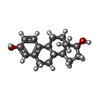[English] 日本語
 Yorodumi
Yorodumi- PDB-5hyr: Estrogen Receptor Alpha Ligand Binding Domain Y537S Mutant in Com... -
+ Open data
Open data
- Basic information
Basic information
| Entry | Database: PDB / ID: 5hyr | ||||||
|---|---|---|---|---|---|---|---|
| Title | Estrogen Receptor Alpha Ligand Binding Domain Y537S Mutant in Complex with Stapled Peptide SRC2-SP2 and Estradiol | ||||||
 Components Components |
| ||||||
 Keywords Keywords | GENE REGULATION / Breast Cancer / Estrogen Receptor / Synthetic Peptide / Stapled Peptide / Endocrine / Hormone | ||||||
| Function / homology |  Function and homology information Function and homology informationregulation of epithelial cell apoptotic process / RNA polymerase II intronic transcription regulatory region sequence-specific DNA binding / antral ovarian follicle growth / regulation of branching involved in prostate gland morphogenesis / RUNX1 regulates transcription of genes involved in WNT signaling / RUNX1 regulates estrogen receptor mediated transcription / regulation of toll-like receptor signaling pathway / nuclear estrogen receptor activity / epithelial cell development / steroid hormone receptor signaling pathway ...regulation of epithelial cell apoptotic process / RNA polymerase II intronic transcription regulatory region sequence-specific DNA binding / antral ovarian follicle growth / regulation of branching involved in prostate gland morphogenesis / RUNX1 regulates transcription of genes involved in WNT signaling / RUNX1 regulates estrogen receptor mediated transcription / regulation of toll-like receptor signaling pathway / nuclear estrogen receptor activity / epithelial cell development / steroid hormone receptor signaling pathway / epithelial cell proliferation involved in mammary gland duct elongation / prostate epithelial cord elongation / prostate epithelial cord arborization involved in prostate glandular acinus morphogenesis / locomotor rhythm / mammary gland branching involved in pregnancy / uterus development / negative regulation of smooth muscle cell apoptotic process / aryl hydrocarbon receptor binding / vagina development / TFIIB-class transcription factor binding / cellular response to Thyroglobulin triiodothyronine / regulation of lipid metabolic process / androgen metabolic process / regulation of glucose metabolic process / Synthesis of bile acids and bile salts / mammary gland alveolus development / cellular response to estrogen stimulus / estrogen response element binding / Synthesis of bile acids and bile salts via 27-hydroxycholesterol / Endogenous sterols / Synthesis of bile acids and bile salts via 7alpha-hydroxycholesterol / Mitochondrial unfolded protein response (UPRmt) / nuclear receptor-mediated steroid hormone signaling pathway / positive regulation of DNA-binding transcription factor activity / negative regulation of DNA-binding transcription factor activity / Nuclear signaling by ERBB4 / cellular response to hormone stimulus / Recycling of bile acids and salts / transcription regulator inhibitor activity / RNA polymerase II preinitiation complex assembly / positive regulation of nitric-oxide synthase activity / estrogen receptor signaling pathway / positive regulation of adipose tissue development / protein localization to chromatin / : / steroid binding / 14-3-3 protein binding / Regulation of lipid metabolism by PPARalpha / peroxisome proliferator activated receptor signaling pathway / regulation of cellular response to insulin stimulus / TFAP2 (AP-2) family regulates transcription of growth factors and their receptors / negative regulation of canonical NF-kappaB signal transduction / BMAL1:CLOCK,NPAS2 activates circadian expression / negative regulation of miRNA transcription / SUMOylation of transcription cofactors / Activation of gene expression by SREBF (SREBP) / response to progesterone / ESR-mediated signaling / TBP-class protein binding / nitric-oxide synthase regulator activity / nuclear estrogen receptor binding / nuclear receptor binding / transcription corepressor binding / transcription coregulator binding / negative regulation of smoothened signaling pathway / stem cell differentiation / SUMOylation of intracellular receptors / mRNA transcription by RNA polymerase II / cellular response to estradiol stimulus / circadian regulation of gene expression / Heme signaling / PPARA activates gene expression / euchromatin / Transcriptional activation of mitochondrial biogenesis / Activated PKN1 stimulates transcription of AR (androgen receptor) regulated genes KLK2 and KLK3 / Cytoprotection by HMOX1 / beta-catenin binding / Transcriptional regulation of white adipocyte differentiation / Nuclear Receptor transcription pathway / RNA polymerase II transcription regulator complex / response to estrogen / Regulation of RUNX2 expression and activity / transcription coactivator binding / male gonad development / nuclear receptor activity / Ovarian tumor domain proteases / : / positive regulation of fibroblast proliferation / Constitutive Signaling by Aberrant PI3K in Cancer / positive regulation of nitric oxide biosynthetic process / sequence-specific double-stranded DNA binding / response to estradiol / PIP3 activates AKT signaling / HATs acetylate histones / positive regulation of cytosolic calcium ion concentration / MLL4 and MLL3 complexes regulate expression of PPARG target genes in adipogenesis and hepatic steatosis / ATPase binding / PI5P, PP2A and IER3 Regulate PI3K/AKT Signaling / regulation of inflammatory response / DNA-binding transcription activator activity, RNA polymerase II-specific Similarity search - Function | ||||||
| Biological species |  Homo sapiens (human) Homo sapiens (human)synthetic construct (others) | ||||||
| Method |  X-RAY DIFFRACTION / X-RAY DIFFRACTION /  SYNCHROTRON / SYNCHROTRON /  MOLECULAR REPLACEMENT / Resolution: 2.271 Å MOLECULAR REPLACEMENT / Resolution: 2.271 Å | ||||||
 Authors Authors | Fanning, S.W. / Speltz, T.E. / Mayne, C.G. / Tajkhorshid, E. / Greene, G.L. / Moore, T.W. | ||||||
 Citation Citation |  Journal: Angew.Chem.Int.Ed.Engl. / Year: 2016 Journal: Angew.Chem.Int.Ed.Engl. / Year: 2016Title: Stapled Peptides with gamma-Methylated Hydrocarbon Chains for the Estrogen Receptor/Coactivator Interaction. Authors: Speltz, T.E. / Fanning, S.W. / Mayne, C.G. / Fowler, C. / Tajkhorshid, E. / Greene, G.L. / Moore, T.W. | ||||||
| History |
|
- Structure visualization
Structure visualization
| Structure viewer | Molecule:  Molmil Molmil Jmol/JSmol Jmol/JSmol |
|---|
- Downloads & links
Downloads & links
- Download
Download
| PDBx/mmCIF format |  5hyr.cif.gz 5hyr.cif.gz | 202.8 KB | Display |  PDBx/mmCIF format PDBx/mmCIF format |
|---|---|---|---|---|
| PDB format |  pdb5hyr.ent.gz pdb5hyr.ent.gz | 161.2 KB | Display |  PDB format PDB format |
| PDBx/mmJSON format |  5hyr.json.gz 5hyr.json.gz | Tree view |  PDBx/mmJSON format PDBx/mmJSON format | |
| Others |  Other downloads Other downloads |
-Validation report
| Summary document |  5hyr_validation.pdf.gz 5hyr_validation.pdf.gz | 980.5 KB | Display |  wwPDB validaton report wwPDB validaton report |
|---|---|---|---|---|
| Full document |  5hyr_full_validation.pdf.gz 5hyr_full_validation.pdf.gz | 985.1 KB | Display | |
| Data in XML |  5hyr_validation.xml.gz 5hyr_validation.xml.gz | 21.8 KB | Display | |
| Data in CIF |  5hyr_validation.cif.gz 5hyr_validation.cif.gz | 30.2 KB | Display | |
| Arichive directory |  https://data.pdbj.org/pub/pdb/validation_reports/hy/5hyr https://data.pdbj.org/pub/pdb/validation_reports/hy/5hyr ftp://data.pdbj.org/pub/pdb/validation_reports/hy/5hyr ftp://data.pdbj.org/pub/pdb/validation_reports/hy/5hyr | HTTPS FTP |
-Related structure data
| Related structure data | 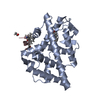 5dx3C 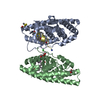 5dxbC  5dxeC  5dxgC 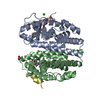 3erdS C: citing same article ( S: Starting model for refinement |
|---|---|
| Similar structure data |
- Links
Links
- Assembly
Assembly
| Deposited unit | 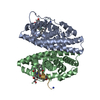
| ||||||||
|---|---|---|---|---|---|---|---|---|---|
| 1 |
| ||||||||
| Unit cell |
|
- Components
Components
| #1: Protein | Mass: 29242.379 Da / Num. of mol.: 2 / Fragment: UNP Residues 302-559 / Mutation: Y537S Source method: isolated from a genetically manipulated source Source: (gene. exp.)  Homo sapiens (human) / Gene: ESR1, ESR, NR3A1 / Production host: Homo sapiens (human) / Gene: ESR1, ESR, NR3A1 / Production host:  #2: Protein/peptide | Mass: 1429.733 Da / Num. of mol.: 2 / Source method: obtained synthetically / Source: (synth.) synthetic construct (others) / References: UniProt: Q15596*PLUS #3: Chemical | #4: Chemical | #5: Water | ChemComp-HOH / | |
|---|
-Experimental details
-Experiment
| Experiment | Method:  X-RAY DIFFRACTION / Number of used crystals: 1 X-RAY DIFFRACTION / Number of used crystals: 1 |
|---|
- Sample preparation
Sample preparation
| Crystal | Density Matthews: 2.14 Å3/Da / Density % sol: 42.5 % |
|---|---|
| Crystal grow | Temperature: 293.15 K / Method: vapor diffusion, hanging drop / pH: 8 / Details: PEG 3,350, MgCl2, Tris pH 8.0 |
-Data collection
| Diffraction | Mean temperature: 77 K |
|---|---|
| Diffraction source | Source:  SYNCHROTRON / Site: SYNCHROTRON / Site:  APS APS  / Beamline: 19-BM / Wavelength: 0.987 Å / Beamline: 19-BM / Wavelength: 0.987 Å |
| Detector | Type: SBC-3 / Detector: CCD / Date: Aug 11, 2015 |
| Radiation | Protocol: SINGLE WAVELENGTH / Monochromatic (M) / Laue (L): M / Scattering type: x-ray |
| Radiation wavelength | Wavelength: 0.987 Å / Relative weight: 1 |
| Reflection | Resolution: 2.27→26.63 Å / Num. obs: 23579 / % possible obs: 99.8 % / Redundancy: 3.7 % / Rmerge(I) obs: 0.092 / Net I/σ(I): 1.6 |
| Reflection shell | Resolution: 2.27→2.4 Å |
- Processing
Processing
| Software |
| |||||||||||||||||||||||||||||||||||||||||||||||||||||||||||||||||||||||||||||||||||||||||||||||||||||||||||||||||||||||||||||||||||||||||||||||||||||||||||||||||||||||||||||||
|---|---|---|---|---|---|---|---|---|---|---|---|---|---|---|---|---|---|---|---|---|---|---|---|---|---|---|---|---|---|---|---|---|---|---|---|---|---|---|---|---|---|---|---|---|---|---|---|---|---|---|---|---|---|---|---|---|---|---|---|---|---|---|---|---|---|---|---|---|---|---|---|---|---|---|---|---|---|---|---|---|---|---|---|---|---|---|---|---|---|---|---|---|---|---|---|---|---|---|---|---|---|---|---|---|---|---|---|---|---|---|---|---|---|---|---|---|---|---|---|---|---|---|---|---|---|---|---|---|---|---|---|---|---|---|---|---|---|---|---|---|---|---|---|---|---|---|---|---|---|---|---|---|---|---|---|---|---|---|---|---|---|---|---|---|---|---|---|---|---|---|---|---|---|---|---|---|
| Refinement | Method to determine structure:  MOLECULAR REPLACEMENT MOLECULAR REPLACEMENTStarting model: 3ERD Resolution: 2.271→23.634 Å / SU ML: 0.33 / Cross valid method: FREE R-VALUE / σ(F): 1.36 / Phase error: 27.57 / Stereochemistry target values: ML
| |||||||||||||||||||||||||||||||||||||||||||||||||||||||||||||||||||||||||||||||||||||||||||||||||||||||||||||||||||||||||||||||||||||||||||||||||||||||||||||||||||||||||||||||
| Solvent computation | Shrinkage radii: 0.9 Å / VDW probe radii: 1.11 Å / Solvent model: FLAT BULK SOLVENT MODEL | |||||||||||||||||||||||||||||||||||||||||||||||||||||||||||||||||||||||||||||||||||||||||||||||||||||||||||||||||||||||||||||||||||||||||||||||||||||||||||||||||||||||||||||||
| Refinement step | Cycle: LAST / Resolution: 2.271→23.634 Å
| |||||||||||||||||||||||||||||||||||||||||||||||||||||||||||||||||||||||||||||||||||||||||||||||||||||||||||||||||||||||||||||||||||||||||||||||||||||||||||||||||||||||||||||||
| Refine LS restraints |
| |||||||||||||||||||||||||||||||||||||||||||||||||||||||||||||||||||||||||||||||||||||||||||||||||||||||||||||||||||||||||||||||||||||||||||||||||||||||||||||||||||||||||||||||
| LS refinement shell |
| |||||||||||||||||||||||||||||||||||||||||||||||||||||||||||||||||||||||||||||||||||||||||||||||||||||||||||||||||||||||||||||||||||||||||||||||||||||||||||||||||||||||||||||||
| Refinement TLS params. | Method: refined / Refine-ID: X-RAY DIFFRACTION
| |||||||||||||||||||||||||||||||||||||||||||||||||||||||||||||||||||||||||||||||||||||||||||||||||||||||||||||||||||||||||||||||||||||||||||||||||||||||||||||||||||||||||||||||
| Refinement TLS group |
|
 Movie
Movie Controller
Controller



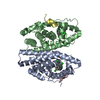

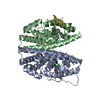

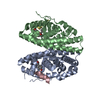
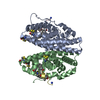

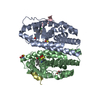

 PDBj
PDBj















